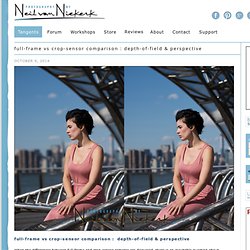

Who Pays Photographers? Full-frame vs crop-sensor comparison : depth-of-field & perspective. When the differences between full-frame and crop-sensor cameras are discussed, there is an inevitable question about whether the crop sensor multiplies the focal length.

Whether a 50mm lens on a crop-sensor acts like a 75mm lens (on a 1.5x crop sensor) or 80mm lens (on a 1.6x crop sensor). The answers given on the photography forums are confusing – yes, the focal length effectively increases. No, it doesn’t. Two polar opposite answers. The discussion (which tend to devolve into arguments) are convincingly made for both sides. One argument goes along the lines that the crop sensor is just that, a crop. With this article, I want to help analyze what happens when you change lenses between a full-frame camera and a crop-sensor camera. Since this article ended up being a long meandering discussion, I thought it best that we start with the final summary. Summary: But let’s discuss this with some images: notes on depth-of-field / DoF shallow depth of field is NOT the same as bokeh. Small pixel sensors do not have worse performance.
It is often stated that an image sensor with small pixels will create digital images that have worse performance characteristics (more noise, less dynamic range, lower sensitivity, worse color depth, more lens aberrations, worse diffraction, and more motion blur) than those created by a sensor with large pixels. I disagree. Of all the reasons why the misconception is so widly believed, these three remain most prominent: flawed image analysis, flawed reasoning, and flawed authorities. But the greatest of these is image analysis. The five most common types of image analysis mistakes are: * Unequal spatial frequencies. * Unequal sensor sizes. * Unequal processing. * Unequal standards. * Unequal technology. When image analysis is performed correctly, it becomes very clear to the viewer of an image that it is possible for small pixel sensors to have worse performance per pixel, but the same performance when actually displayed or used for the same purpose as a large pixel sensor.
{*style:<u> </u>*} The understated utility of smaller pixels. Most statements about megapixels understate their usefulness.

For example, it is often stated that when you're only printing an 8x12, it's impossible to tell the difference between an 8 MP camera and a 15 MP camera. But in many common circumstances, the difference is striking. That is not to say that high MP is necessarily a requirement for a good photo. I have enjoyed beautiful 20x30 prints that were made with less than 2 MP. Most film theaters only achieve resolution equivalent to 0.9 MP (some digital ones are up to 2.4 MP), yet people sit close to the 50 foot screens and enjoy the cinematography anyway.
At what point does additional resolution contributes no discernible improvement to the displayed photograph? Given the same resolution per area, a larger display can benefit from more megapixels than a small display (e.g. 20x30 vs 4x6). Given the same display size, a high resolution display can benefit from more megapixels than a low-resolution display (e.g. 300 ppi vs 72 ppi). Photography - Stack Exchange.